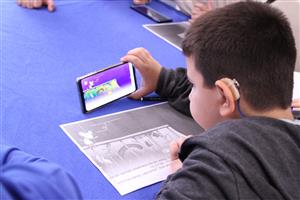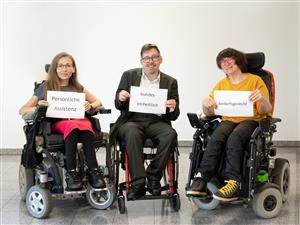Search Results
Search
Filter results
Advanced Filters
Your search returned 141 Solutions
-

Storytelling mobile app for children who are deaf or blind
In 2019 the Turkish Association of the Deaf (TIED) launched an interactive video app aimed at children with hearing disabilities that functions like an audio-visual library. The audio description, introduced in 2022, makes the library also accessible for children with visual impairments.
Association of People with Hearing Impairment of Turkey, İki-Dilli Öyküler (Bilingual stories), Turkey -

Haptic technology to improve mobile app accessibility
Tencent Holdings is a technology and entertainment company from China that has developed ‘MTGPA Haptics’, a technology that transmits vibro-tactile signals to its users and can be used for notifications or as an orientation aid. By 2022, MTGPA Haptics had been installed in over 240 million smart phones.
TENCENT Technology Co,. Ltd., MTGPA Haptics, China -

An Inclusive Election Guide developed in a Sub-Saharan Country
In the run-up to the 2015 elections in Burkina Faso, Light for the World facilitated solutions that removed barriers for persons with disabilities regarding political participation. An inclusive election guide was developed, ballots were printed in Braille, and legislative bodies hired people with disabilities to ensure equality.
Light for The World Burkina Faso, Inclusive Election Guide, Burkina Faso -

Easy-to-use method for connecting communities, service providers, and the government
Citizen, Voice, and Action (CVA) is a World Vision initiative to empower people with disabilities in dialogue with public institutions to improve services such as health care and education at the local level. By 2022 the model had been implemented in more than 50 countries.
World Vision United States of America, Citizen, Voice, and Action (CVA), Colombia -

Countrywide working group making elections more accessible
Disability Inclusive Elections Sri Lanka’ is a working group of the International Foundation for Electoral Systems (IFES) in Sri Lanka, which, in collaboration with the National Election Commission, has designed and implemented strategies and measures for the political and electoral inclusion of persons with disabilities.
International Foundation for Electoral Systems, Disability Inclusive Elections Sri Lanka (DIESL) Technical Working Group, Sri Lanka -

Music workshops and an orchestra for youth with disabilities
The Music Workshop’ is a project operating within Milan Petrović, a boarding school and day-care centre for youth with disabilities in Novi Sad, Serbia. Using innovative assistive technologies, participants learn to create and interpret music. In 2016 the workshops led to the creation the Good People Orchestra.
Primary and Secondary Boarding School Milan Petrovic, Novi Sad, Serbia, An accessible music programme, Serbia -

Persons with intellectual disabilities becoming self-advocates in politics
Beit Issie Shapiro (BIS) and Israel Elwyn, both from Israel, launched a self- and collective-advocacy and leadership development programme for people with intellectual disabilities in 2011. By 2022 the number of self-advocates increased from 20 to 150, and the Israeli government regularly requests their input.
Beit Issie Shapiro, A self and collective advocacy and leadership development programme for people with Intellectual Disabilities, Israel -

Facilitating personal assistance service provision to persons with disabilities
WAG Assistenzgenossenschaft (WAG), an Austrian non-profit cooperative founded by people with disabilities, has been operating a personal assistance service model since 2002. The model allows high flexibility for the beneficiaries, and WAG acts as a legal employer for 685 assistants as of 2022.
WAG Assistenzgenossenschaft, Cooperative personal assistance model in Austria, Austria -

QR Codes used to inform voters who are blind or deaf about voting procedures
In the run-up to the 2020 local elections in Ukraine, the International Foundation for Electoral Systems (IFES) joined forces with the Central Election Commission of Ukraine to develop information posters with QR codes. These were linked to audio and sign language formats and were used by approximately 6,000 people.
International Foundation for Electoral Systems, Accessible Voter Education in Ukraine, Ukraine -

People-centred housing services for persons with psychosocial disabilities
Founded by Support-Girona from Spain in 2018, the Housing Commission supports people with psychosocial disabilities to access housing. A person-centred methodology ensures that they can decide for themselves where and how they want to live. By 2022 more than 50 people have found housing in this way.
Support Girona, Top House Housing Commission, Spain